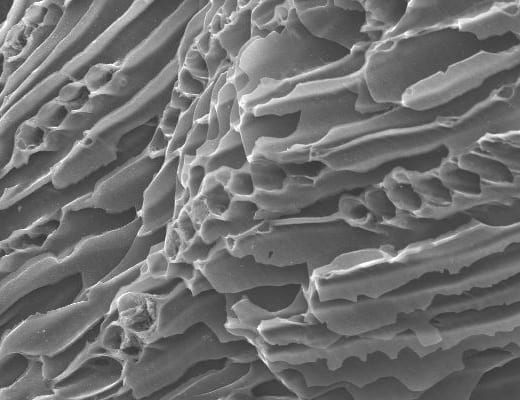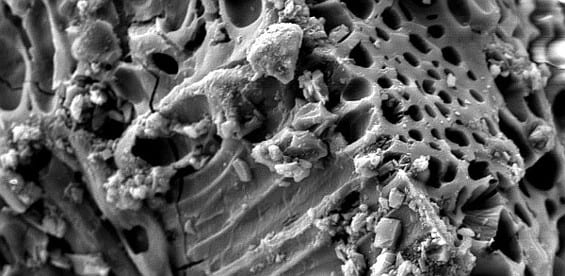Biochar is the solid, carbon-rich coproduct produced when biomass is converted to energy in an oxygen-controlled environment. Biochar production, in conjunction with forestry product systems, provides the opportunity to treat underused biomass (such as forest fuel load reductions, slash from tree harvest and planer shavings) in an economic and environmentally beneficial way.
Biochar production is the result of an exothermic thermal chemical process. The low-oxygen, high-temperature conversion of waste biomass produces two useful products: excess energy that can be sold and biochar.
Because the carbon that the tree uses to build its structure comes from photosynthesis, the resulting biochar is an atmospheric carbon removal mechanism. Biochar has economic and environmental benefits because it contributes to carbon sequestration, long-term soil fertility, and can assist in remediation of contaminated soils and water.
Biochar production results in a porous, low density, carbon rich, high surface area material. During production, part of the biomass volatilizes into combustible gasses that are used to produce bio-energy. The remaining biomass becomes biochar – a lattice work of thermally altered, stabilized carbon with a half-life in the order of thousands of years. Thus, the biochar strategy has three simultaneous goals:
- Production of renewable biomass energy.
- Removal of carbon from the atmosphere.
- Production of environmentally beneficial and valuable co-products.

The large surface areas and cation exchange capacities of biochars, determined by source materials and pyrolysis temperatures, enables enhanced sorption of both organic and inorganic contaminants to their surfaces.
Biochars are distinguished from activated carbon because the source materials are generally limited to biological waste materials (such as wood, poultry litter, crop residues) and are not commonly activated or further treated. Symmetries may be drawn between activated carbons and biochars with several studies, including one conducted at Oregon State University, establishing that biochars can remove heavy metals from aqueous solution just as effectively as more expensive activated carbons.
Biochar can be produced from a range of biomass waste products and has been used to:
- Increase soil fertility in poor and degraded soils.
- Replace vermiculite in potting media.
- Remediate contaminated soils.
- Reduce odor emissions from composting operations.
- Remove dissolved contaminants from stormwater.
Interest in biochar is growing. When it is made properly (from appropriately sourced waste biomass) it can act as a long-term carbon sink. Major corporations that are seeking to reduce their carbon footprint are purchasing certified biochar as a component of their carbon offset strategies.

Over the last fifteen years, BioLogical Carbon, LLC, and their associates have worked to develop markets for biochar, focusing on its use as a soil amendment or water filtration product. Our hope is biochar becomes a major new product in Oregon and other western states — generating new green jobs and creating new revenue streams for forest landowners, while also reducing carbon emissions.
To better understand the valuable uses of biochar in forestry, we are developing long-term research goals. In the short term, we are determining the potential benefits biochar bring to the forest:
- Tree planting establishment.
- Slope stabilization.
- Water infiltration.
- Watershed protection.
- Post-fire landscape recovery.
- Building soil carbon stocks.
We are excited to have a new pathway to help maintain the long-term sustainability of not only our own forests, but our entire ecosystem. We hope more people will support these efforts by giving biochar a try. If you are interested in learning more about biochar’s potential, read more about case studies in our region and feel free to contact us for more information.
Subscribe
We’ll send you a notification when a new story has been posted. It’s the easiest way to stay in the know.